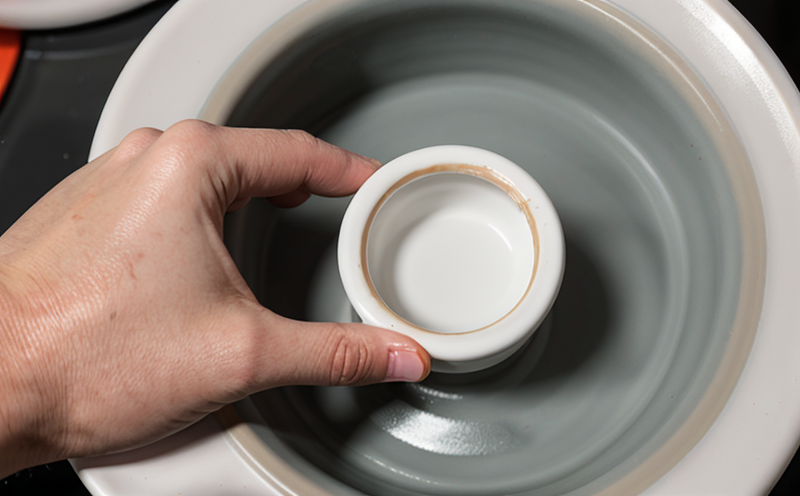ISO 23153 Ionic Conductivity of Nanostructured Ceramics
The ISO 23153 standard provides a robust framework for measuring ionic conductivity in nanostructured ceramics. This test is critical for ensuring the reliability and performance of nanomaterials used in various applications, including fuel cells, batteries, and sensors.
Understanding ionic conductivity at the nano-scale level is essential because it directly impacts the material's functionality within a device or system. The standard outlines precise procedures to prepare and test samples under controlled conditions to ensure accurate results. This process involves intricate specimen preparation, which includes grinding and sieving techniques specific to nanomaterials.
The ISO 23153 method is designed for nanostructured ceramics with grain sizes below micrometers, where conventional testing methods may not provide reliable data due to the small dimensions of the grains. By following this standard, researchers and manufacturers can ensure that their materials meet stringent quality control requirements and are suitable for advanced technological applications.
The procedure involves several key steps: initial sample characterization, preparation of test specimens, application of an electric field, measurement of ionic current density, calculation of conductivity, and reporting the results. Each step is critical to obtaining accurate and reproducible data.
For effective specimen preparation, it’s crucial to consider the unique properties of nanostructured ceramics. The grain size distribution and morphology significantly influence the electrical behavior of these materials. Therefore, using appropriate grinding media and sieving methods ensures that the sample retains its nanoscale characteristics without compromising the integrity of the structure.
The application of an electric field is another critical aspect of this test. The strength and duration of the field must be precisely controlled to avoid altering the ionic conductivity due to external factors. The use of high-purity electrolytes and electrodes further ensures accurate measurement.
Once the ionic current density is measured, it is used in conjunction with other parameters such as temperature and grain size distribution to calculate the ionic conductivity. This calculation requires careful attention to detail and adherence to the standard's specified formulas.
The final step involves reporting the results according to ISO standards. This report should include all relevant data, including the preparation method, test conditions, and calculated conductivity values. Providing this detailed information ensures transparency and reproducibility of the testing process.
By adhering strictly to the ISO 23153 standard, laboratories can perform accurate and reliable tests on nanostructured ceramics. This not only enhances the quality of the materials but also facilitates better integration into advanced technological applications.
Scope and Methodology
| Step | Description |
|---|---|
| Sample Characterization | Determine the grain size distribution, morphology, and other relevant properties. |
| Preparation of Test Specimens | Grind and sieve to maintain nanoscale characteristics without structural damage. |
| Application of Electric Field | Apply a controlled electric field for precise measurement. |
| Measurement of Ionic Current Density | Measure the ionic current density accurately using appropriate equipment. |
| Calculation of Conductivity | Calculate conductivity based on measured data and standard formulas. |
| Reporting Results | Report all relevant data according to ISO standards. |
Benefits
The implementation of the ISO 23153 standard offers several advantages in nanomaterial testing. Primarily, it ensures consistent and accurate measurement of ionic conductivity across different laboratories and manufacturers.
This consistency is crucial for ensuring that nanostructured ceramics meet the required performance standards. By adhering to this international standard, researchers and industry professionals can rely on standardized procedures that are validated through rigorous testing protocols.
The standard also facilitates better integration of nanomaterials into advanced technological applications by providing reliable data on their electrical properties. This enhanced reliability supports innovation in fuel cells, batteries, sensors, and other high-tech devices.
Moreover, the ISO 23153 method helps to streamline the testing process, reducing the time and resources required for quality assurance. The standardization of procedures ensures that tests are repeatable and reproducible, leading to more efficient product development cycles.
The use of this standard also promotes transparency in nanomaterial testing, allowing stakeholders to have confidence in the results. This trust is vital in regulatory compliance and market acceptance of advanced materials.
In summary, ISO 23153 provides a robust framework for accurate and reliable measurement of ionic conductivity in nanostructured ceramics. Its benefits include consistency, reliability, efficiency, transparency, and support for innovation in advanced technologies.
Customer Impact and Satisfaction
- Quality Assurance: Ensures that nanomaterials meet stringent quality control requirements.
- Innovation: Supports the development of new materials with enhanced electrical properties.
- Regulatory Compliance: Facilitates adherence to international standards, ensuring compliance with regulations.
- Market Acceptance: Enhances confidence in advanced technological products through reliable testing data.
- Efficiency: Streamlines the testing process, reducing time and resource requirements for quality assurance.
- Transparency: Provides clear reporting of test results, fostering trust among stakeholders.





